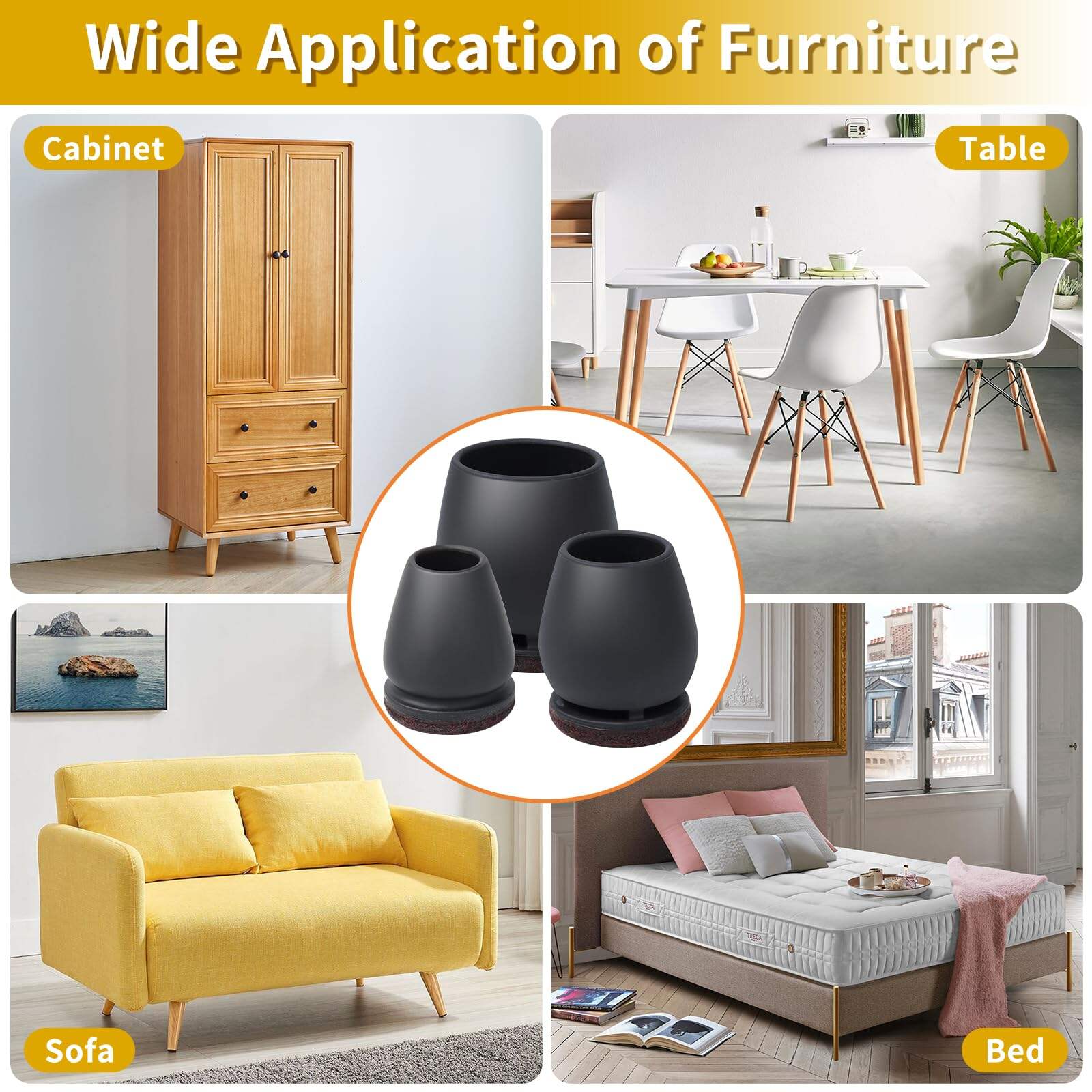Why Are Chair Foot Pads Essential for Hardwood Floors?
The Importance of Chair Foot Pads for Hardwood Floors
Preventing Scratches and Surface Damage
Chair foot pads play a crucial role in maintaining the integrity and beauty of hardwood floors. They act as a protective buffer between the chair legs and the flooring, significantly reducing the risk of scratches that can occur from dragging and moving furniture. Studies indicate that using protective pads can decrease the likelihood of scuff marks and surface damage by up to 80%. This preventative measure ensures that your hardwood floors remain aesthetically pleasing, minimizing the need for costly refinishing over time.
Reducing Noise During Chair Movement
In addition to protecting floors, chair foot pads are effective in noise reduction. They absorb the sounds generated when moving chairs, making them ideal for environments where maintaining low noise levels is essential, such as offices and libraries. Research shows that soft pads can reduce noise by approximately 30%, leading to a quieter and more pleasant living or working environment. This noise-dampening capability enhances the overall comfort and ambiance of shared spaces.
Extending Floor Lifespan and Maintaining Value
Incorporating chair foot pads into your home maintenance routine can significantly extend the lifespan of hardwood floors and maintain their value. By preventing long-term damage, these pads help preserve the condition of your floors, saving homeowners from premature replacement costs. Research suggests that floors protected with proper pads experience less wear and tear over time. Regular use of chair foot pads not only upholds the market value of your hardwood floors but also makes your home more appealing to potential buyers, who often favor properties with well-maintained surfaces.
Types of Chair Foot Pads and Leg Protectors
Silicone vs. Felt Pads: Key Differences
When choosing between silicone and felt chair foot pads, each type caters to different needs. Silicone pads are known for their flexibility and superior adhesion, making them ideal for heavier furniture as they provide a stronger grip on both the chair leg and the floor. This feature ensures that the furniture remains stable, minimizing movement that can lead to scratches. In contrast, felt pads offer a smoother, more integrated look with hardwood floors; however, they tend to wear out faster and may require more frequent replacements. By understanding these key differences, consumers can make more informed choices that best suit their specific flooring needs and aesthetic preferences.
Rubber Chair Leg Caps for Heavy-Duty Use
For environments where heavy furniture is constantly in use, rubber chair leg caps stand out as a robust solution. These caps are designed to absorb shocks, thereby reducing the damage risk to floor surfaces. They are especially useful in high-traffic areas or on outdoor decks, where durability is a primary concern. Statistical evidence suggests that rubber pads outlast felt pads under continuous or heavy usage, making them a reliable option for long-term protection. Their ability to withstand pressure and movement exempts them from frequent replacements, providing an economical and effective solution over time.
Anti-Vibration Pads for Multi-Purpose Protection
Anti-vibration pads serve as a multi-purpose protective accessory, especially for furniture and appliances that generate significant movement, such as washing machines. These pads not only safeguard against scratches but also mitigate vibrations that can weaken furniture joints and the flooring itself. Research indicates that utilizing anti-vibration pads can reduce the shifting of furniture by up to 50%, offering substantial protection. This makes them an invaluable addition to any room where equipment or furniture movement is inevitable, thereby prolonging the life of both the furniture and the hard surfaces they rest upon.
Key Benefits of Using Floor Protectors
Enhanced Stability on Smooth Surfaces
Floor protectors significantly enhance the stability of chairs on smooth surfaces, particularly hardwood floors. This added friction helps prevent accidental sliding, a common issue that increases the risk of slips and falls. Enhancing user safety is crucial, especially in homes with children or elderly individuals. By creating a non-slip surface, floor protectors foster a safer environment, reducing potential hazards. Numerous studies underscore the importance of stability to avoid injuries, highlighting the role of floor protectors in maintaining cautious and secure residential settings.
Compatibility with Different Furniture Leg Shapes
Different chair models come with unique leg shapes, requiring versatile solutions such as chair leg caps to meet their specific needs. Floor protectors excel in compatibility by accommodating various leg designs, from tapered and rounded to square, thus ensuring they suit diverse furniture styles. Consumer reports consistently praise adaptable floor protectors, favoring those that provide effective protection across multiple furniture setups. This versatility helps homeowners maintain their floor’s condition without sacrificing style or functionality.
Moisture Resistance and Non-Slip Performance
Many floor protectors are designed with moisture-resistant materials, safeguarding hardwood floors from spills, humidity, and potential water damage. This moisture resistance is essential for preserving the longevity and aesthetic appeal of your flooring. Additionally, the non-slip features of these pads contribute to user safety by preventing unintended chair movements during use. Expert reviews often highlight the importance of moisture-resistant pads, emphasizing their role in preventing water stains and enhancing the visual appeal of hardwood surfaces. Non-slip performance, combined with moisture resistance, ensures comprehensive protection for your floors.
How to Choose the Right Foot Pads
Measuring Chair Leg Diameter and Shape
Measuring the diameter and shape of your chair legs is crucial when selecting the right foot pads, as a snug fit ensures optimal functionality. To achieve precise measurements, utilize tools like a caliper or measuring tape. This helps avoid the inconvenience of mismatched pads falling off or causing instability. Properly sized pads not only enhance performance but also extend the lifespan of both the pads and your floors, maintaining their appearance and condition over time.
Matching Pad Material to Floor Type
Selecting foot pads suitable for your floor type is essential for protecting both the flooring and the furniture. Different floorings, such as hardwood, tile, or carpet, demand specific pad materials that offer the best protection and reduce wear and tear. Choosing the right material ensures compatibility, prolonging the lifespan of both the pads and floors. Provider guides often present valuable insights to help consumers make well-informed decisions about which materials best suit their needs, saving time and resources in the long term.
Considering Frequency of Chair Movement
Understanding how often you move or reposition chairs greatly influences your choice between soft or hard foot pads. Chairs that undergo frequent movement require more durable pads designed to withstand consistent wear and tear, thereby extending their lifespan. Manufacturers typically provide product recommendations tailored to various usage frequencies, ensuring you select a pad that meets your specific needs. This foresight not only enhances comfort and protection but also optimizes cost-effectiveness by minimizing the need for frequent replacements.
Top-Rated Chair Foot Pads for Hardwood Floor Protection
24 PCS Small Silicone Protectors (Snug Fit for 0.5-0.8" Legs)
These small silicone protectors are specifically designed to provide a snug fit for chair legs ranging from 0.5 to 0.8 inches. Their silicone material not only ensures durability but also keeps them firmly in place, preventing any accidental falls off. Feedback from users frequently highlights their effectiveness in preventing scratches and unnoticed movements, which can often damage hardwood floors.
Thickened Felt Caps for 0.8-1.1" Chair Legs
Thickened felt caps provide a robust solution for protecting chair legs measuring between 0.8 to 1.1 inches, merging durability with aesthetic appeal. Users often commend these caps for their ability to absorb shocks and minimize scratches, contributing significantly to the preservation of hardwood surfaces.
Anti-Vibration Felt Pads for Appliances
Anti-vibration felt pads play a crucial role in mitigating vibrations and preventing damage to floor surfaces caused by heavy appliances. Customers particularly recommend these pads for environments with washer-dryer setups, acknowledging their effectiveness in maintaining floor integrity and reducing operational noise.
Heavy-Duty Adjustable Furniture Risers
The heavy-duty adjustable furniture risers provide an efficient means to elevate furniture, accommodating various height preferences while simultaneously safeguarding floors. Users value the adjustability aspect, which enhances customization according to individual requirements, making these risers a preferred choice for multifunctional spaces.
Square/Round Felt Pads with Universal Sizing
The square and round felt pads boast universal sizing, catering to a wide array of furniture types and making them versatile additions to any home. Their adaptability and ease of use make them highly favored among consumers seeking practical and efficient floor protection solutions.
Installation Tips and Maintenance Practices
Proper Cleaning Before Application
Proper cleaning is crucial before applying chair foot pads to ensure they adhere well and provide long-lasting protection. Begin by cleaning both the floor and chair legs, removing dust and debris that can impede adhesion. Choose non-abrasive cleaners to prevent damage to the wood finish, as overly harsh chemicals can harm both the surface and the adhesive strength of the pads. Following these guidelines helps maintain the effectiveness of products like chair leg caps for metal chairs and rubber chair leg caps.
When to Replace Worn-Out Protectors
Regularly assessing the condition of your chair foot pads is important for maintaining floor protection. Look for signs of wear and tear, such as thinning material or reduced grip, which indicate the need for replacement. Depending on usage frequency and material quality, replacing these protectors every 6-12 months is advisable. Such routine maintenance ensures continued safeguarding against scratches and movement, similar to that achieved with high-quality chair leg metal caps.
Seasonal Adjustments for Temperature Changes
Seasonal temperature changes can significantly impact the performance of chair foot pads. Materials like silicone chair caps and thickened felt caps may shrink or stretch with fluctuations in climate, altering their fit and effectiveness. Homeowners should monitor these indicators and adjust or replace pads as necessary to maintain optimal performance. Prompt attention to these changes ensures the continued protection of both furniture and hardwood floors.

 EN
EN
 AR
AR
 BG
BG
 HR
HR
 CS
CS
 DA
DA
 NL
NL
 FI
FI
 FR
FR
 DE
DE
 EL
EL
 HI
HI
 IT
IT
 JA
JA
 KO
KO
 NO
NO
 PL
PL
 PT
PT
 RO
RO
 RU
RU
 ES
ES
 SV
SV
 CA
CA
 TL
TL
 IW
IW
 ID
ID
 LT
LT
 SR
SR
 SK
SK
 SL
SL
 UK
UK
 VI
VI
 HU
HU
 TR
TR
 AF
AF
 MS
MS
 GA
GA
 LA
LA
 MN
MN






